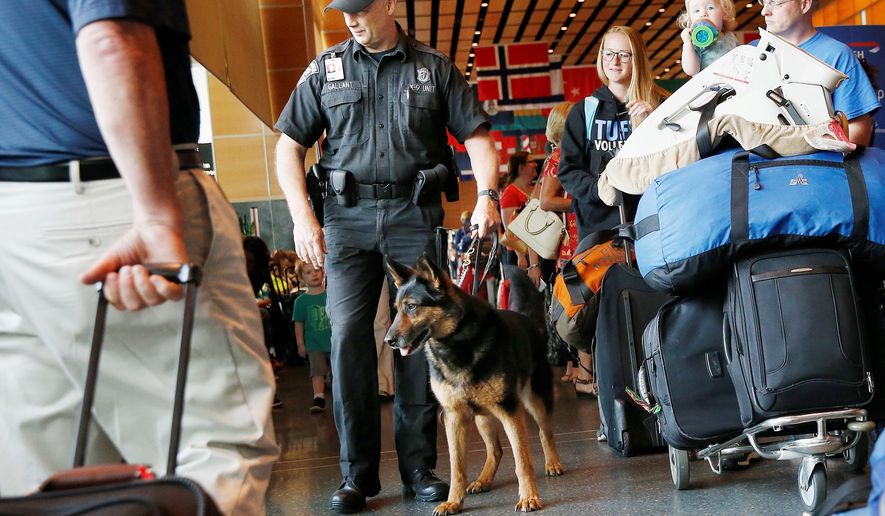The Trump administration is forging ahead with an overhaul of airport security, brushing aside criticism that the president is squandering resources on a border wall while the much-maligned Transportation Security Administration bungles its job.
They are reworking the no-fly list, deploying more bomb-sniffing K-9s at airports and are on schedule to upgrade carry-on baggage screening to high-tech 3-D imaging machines that could speed up lines and help detect bombs and other weapons.
“That is TSA’s plan to leverage technology in the future to improve security of the American public,” said a senior White House official.
The Trump administration has enhanced the no-fly list by entering more intelligence-sharing agreements with foreign governments. Authorities are also shifting to use of biometric data to better identify terrorist suspects on the list.
A major advancement is underway with installing computed-tomography (CT) machines at airport checkpoints to screen carry-on luggage. The imaging, first developed for medical tests, is leaps and bounds ahead of the X-ray machines currently in use.
Like existing CT scanners used for checked baggage, the machines that are sized to fit at checkpoints create such a clear picture of a bag’s contents that computers can automatically detect explosives, including liquids, the agency said.
Instead of the two-dimensional views of a carry-on bag generated by the current checkpoint X-ray machines, CT scanners shoot hundreds of images with an X-ray camera spinning around the conveyor belt to provide screeners with three-dimensional views.
Although TSA officials are optimistic about the advantages of the new technology, they don’t want to speculate about the potential to eliminate rules requiring travelers to remove laptop computers from carry-on bags or limits on the volume of liquids allowed through security gates.
Catching terrorists trying to smuggle explosives aboard airliners remains the top priority for airport security.
Australian authorities in July nabbed a man attempting to smuggle explosives hidden in a meat grinder in carry-on luggage at Sydney Airport. The plot was later linked to Islamic State.
The security guards discovered the meat-grinder bomb only because the bag was overweight, reports say.
The CT machines are being tested at a checkpoint screening lane at Phoenix’s Sky Harbor International Airport and a screening lane at Boston’s Logan International Airport.
The pilot program will expand after the holidays to New York’s John F. Kennedy International Airport, the fifth-busiest airport in the U.S.
TSA expects to have the technology in more airports by the end of next year.
The agency has been on the hot seat for years about its performance. Recent undercover tests by the Department of Homeland Security inspector general’s office reportedly found that TSA checkpoints failed to detect as much as 80 percent of prohibited items that were planted in baggage.
“In an era of lone wolf terrorists, the continued TSA security failures at airports across the country are highly concerning and a major threat we must neutralize,” said Senate Minority Leader Charles E. Schumer, New York Democrat. “In light of the recent test result reports, TSA should move immediately to address all holes, shortfalls and gaps in training procedures, technology, and the entire airport security process.”
Details of the inspector general’s report remain classified and are available only to select lawmakers.
Previous undercover tests of TSA airport checkpoints, including one this year at the Minneapolis-Saint Paul International Airport, found a failure rate topping 95 percent.
“We take the OIG’s findings very seriously and are implementing measures that will improve screening effectiveness at checkpoints,” said TSA Administrator David Pekoske. “We are focused on staying ahead of a dynamic threat to aviation with continued investment in the workforce, enhanced procedures and new technologies.”
The CT scanners are part of that response.
Despite the poor performance in the tests, the TSA finds and confiscates thousands of prohibited items. Last year, agents seized 3,391 firearms, a record that TSA expects to break this year.
During a single week in October, TSA discovered 90 firearms in carry-on bags across the nation. Of the 90 firearms, 77 were loaded and 28 had a round chambered, according to the agency.
The screeners also come across some bizarre items.
Items that the TSA considered its strangest finds in 2016 included:
• Five dead endangered seahorses in a large liquor bottle at Detroit Metropolitan Wayne County Airport.
• A replica of the barbed-wire-wrapped “Lucille” bat from the “Walking Dead” TV series seized at Hartsfield-Jackson Atlanta International Airport.
• A trailer hitch adorned with a inert hand grenade at California’s San Luis Obispo County Regional Airport.
In February at Dallas/Fort Worth International Airport, TSA agents seized 22 pounds of illegal raw animal organs, including raw pig and cow brains, hearts, tongues and heads.
The agents regularly find “firearm components, realistic replica firearms, BB and pellet guns, airsoft guns, brass knuckles, ammunition, batons, stun guns, small pocketknives and many other prohibited items too numerous to note,” according to the TSA blog.
Last year, TSA screened more than 2 million passengers daily and 466 million checked bags.
• S.A. Miller can be reached at smiller@washingtontimes.com.




Please read our comment policy before commenting.